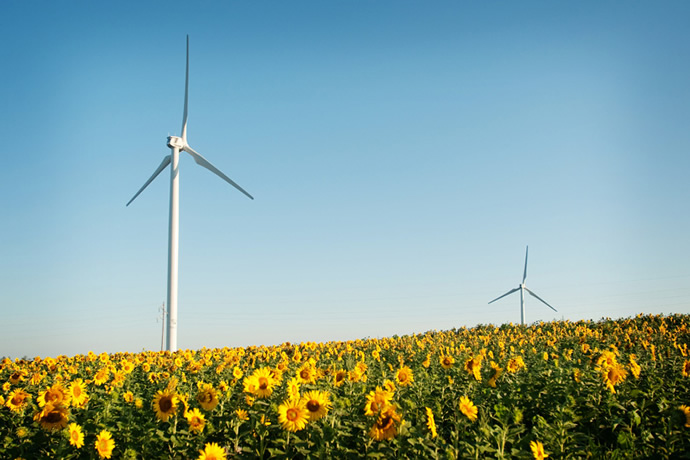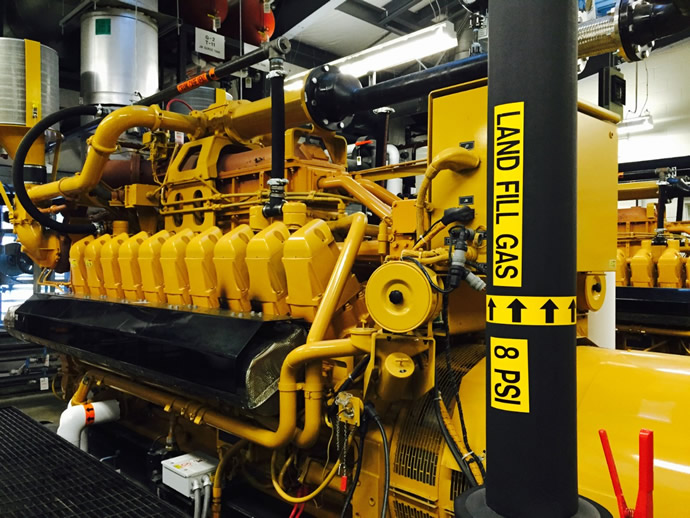The same car company that just pledged $5.4 billion in US investment over the next three years is flashing its green in other ways too.
General Motors’ Fort Wayne Assembly Plant — 43 percent powered by methane captured from decomposing trash in a nearby landfill — ranks No. 5 among the U.S. Environmental Protection Agency’s top 30 generators of onsite green power.
The plant’s generation of 53 million kilowatt hours of green power could supply the equivalent electricity use of more than 5,000 American homes annually.
“Renewable energy enables us to reduce risk at our plants and save money on energy costs — facts that prove there’s economic opportunity in addressing climate change,” said Rob Threlkeld, GM global manager of renewable energy. “None of our US plants use coal as an energy source.”
GM is one of the largest industrial users of landfill gas in the United States. Fort Wayne Assembly has used landfill gas for 13 years and brought the generation process on site last year to quadruple usage to 43 percent of overall energy usage. The operation also hosts a 14.4-kilowatt solar array, and is landfill-free, meaning it reuses, recycles or converts to energy all waste from daily operations.
The company’s $24-million equipment investment also applied to its plant in Orion, Mich., and is expected to save the company a combined $10 million a year in energy costs.
Orion has been using biogas for 16 years, and it now represents 54 percent of the plant’s energy usage.
“With this project in place, we are converting landfill gas into our own electricity, which, in essence, allows us to act as our own utility,” said Bill Mortimer, GM co-generation project manager in Orion, when the original investment was announced in December 2013.
The projects are part of an overall commitment by GM to use 125 megawatts of renewable energy by 2020 — a goal it expects to exceed four years early.
The new EPA Top 30 onsite green power users (listed below) include 15 private-sector companies and a number of automotive firms, among them BMW in South Carolina (No. 4 in onsite power usage, from biogas) and VW in Tennessee (No. 15), where a solar installation produces 15 percent of the site’s power.
The top of that Top 30 includes select locations at No. 1 Wal-Mart (158.7 kWh) and No. 2 Apple (112 kWh). Also notable on the list is Google, which comes in at 20th, but whose biogas and solar combination still only represents less than 1 percent of total onsite energy usage.
The companies whose onsite green power represents the highest percentage of overall electricity use are both agriculture firms: No. 16 Cooper Farms, a northwestern Ohio turkey farm that gets 81 percent of its power from wind; and No. 29 Organic Valley/CROPP Cooperative, based in La Farge, Wis., which gets 81 percent of its power usage from wind and solar.

A $6.7-million headquarters expansion completed by Organic Valley in 2012 not only added 67 jobs in southwestern Wisconsin, but included 20 special solar power-generating windows. In 2011 the organization partnered with Gundersen Health System to build Cashton Greens Wind Farm, Wisconsin’s first community wind project, next door to the Organic Valley distribution center in Cashton, Wis.
The Top 30 On-site Generation list represents those partners generating and consuming the most green power on-site within the Green Power Partnership, which encompasses 1,300 partner organizations nationwide.
| Company | Green Power Use (kWh) | % Total Use* | On-Site Resources | Purchased Green Power (kWh) |
|---|---|---|---|---|
| Wal-Mart Stores, Inc./Select Locations | 158,732,026 | 8% | Solar, Wind | 156,111,246 |
| Apple Inc. | 112,064,200 | 17% | Biogas, Solar | 541,251,300 |
| U.S. Department of Energy | 110,179,367 | 2% | Biomass, Solar, Wind | 519,789,800 |
| BMW Manufacturing Co. / Greer, SC Facilities | 69,383,477 | 37% | Biogas | 0 |
| General Motors / GMVM Ft. Wayne | 53,260,800 | 43% | Biogas | 0 |
| City of Philadelphia, PA | 44,790,000 | 6% | Solar | 9,900,000 |
| Coca-Cola Refreshments | 34,354,074 | 4% | Biogas, Solar | 0 |
| University of Missouri | 32,584,935 | 13% | Biomass, Solar, Wind | 24,379,000 |
| Kohl’s Department Stores | 31,197,690 | 2% | Solar | 1,500,000,000 |
| SC Johnson & Son, Inc. | 26,790,000 | 16% | Biogas, Wind | 47,730,000 |
| City ofSan Diego, CA | 20,344,825 | 8% | Solar | 0 |
| Kaiser Permanente / California, Colorado, Northwest, and Mid-Atlantic Regions | 18,113,054 | 9% | Solar | 34,948,277 |
| City of Portland, OR | 13,578,000 | 9% | Solar | 74,935,000 |
| Yolo County, CA | 13,501,338 | 152% | Solar | 0 |
| Volkwagen Group of America Chattanooga Operations, LLC | 13,301,992 | 15% | Solar | 0 |
| Cooper Farms | 12,929,849 | 81% | Wind | 0 |
| Encina Wastewater Authority | 11,966,400 | 82% | Biogas | 0 |
| Adobe Systems Incorporated | 11,666,667 | 18% | Biogas | 52,342,000 |
| County of Santa Clara, CA | 11,412,175 | 9% | Solar | 0 |
| Google Inc. | 9,516,664 | <1% | Biogas, Solar | 869,636,000 |
| University of Iowa | 9,035,850 | 4% | Biomass | 0 |
| Ahold USA | 8,867,165 | <1% | Solar | 148,700,000 |
| Safeway Inc. / Select Locations | 7,903,591 | 12% | Biogas, Solar, Wind | 0 |
| City of Tulare, CA / Wastewater Treatment Plant | 7,519,000 | 30% | Biogas, Solar | 0 |
| City of Santa Cruz, CA / WastewaterTreatment Facility | 7,499,577 | 70% | Biogas, Solar | 0 |
| Victor Valley Wastewater Reclamation Authority | 7,446,000 | 74% | Biogas | 0 |
| Butte College | 7,001,941 | 90% | Solar | 0 |
| City of Las Vegas, NV | 6,978,235 | 6% | Solar | 0 |
| Organic Valley / CROPP Cooperative | 5,984,037 | 81% | Solar, Wind | 0 |
| University of Minnesota, Morris | 5,579,067 | 63% | Biomass, Solar, Wind | 0 |

